标签:
一、什么是OAuth
OAuth是一个关于授权(Authorization)的开放网络标准,目前的版本是2.0版。注意是Authorization(授权),而不是Authentication(认证)。用来做Authentication(认证)的标准叫做openid connect,我们将在以后的文章中进行介绍。
二、名词定义
理解OAuth中的专业术语能够帮助你理解其流程模式,OAuth中常用的名词术语有4个,为了便于理解这些术语,我们先假设一个很常见的授权场景:
你访问了一个日志网站(third party application),你(client)觉得这个网站很不错,准备以后就要在这个网站上写日志了,所以你准备把QQ空间(Resource owner)里面的日志都导入进来。此日志网站想要导入你在QQ空间中的日志需要知道你的QQ用户名和密码才行,为了安全期间你不会把你的QQ用户名和密码直接输入在日志网站中,所以日志网站帮你导航到了QQ认证界面(Authorization Server),当你输入完用户名和密码后,QQ认证服务器返回给日志网站一个token, 该日志网站凭借此token来访问你在QQ空间中的日志。
三、OAuth2.0中的四种模式
OAuth定义了四种模式,覆盖了所有的授权应用场景:
前面我们假设的场景可以用前两种模式来实现,不同之处在于:
当日志网站(third party application)有服务端,使用模式1;
当日志网站(third party application)没有服务端,例如纯的js+html页面需要采用模式2;
本文主描述利用OAuth2.0实现自己的WebApi认证服务,前两种模式使用场景不符合我们的需求。
四、选择合适的OAuth模式打造自己的webApi认证服务
场景:你自己实现了一套webApi,想供自己的客户端调用,又想做认证。
这种场景下你应该选择模式3或者4,特别是当你的的客户端是js+html应该选择3,当你的客户端是移动端(ios应用之类)可以选择3,也可以选择4。
密码模式(resource owner password credentials)的流程:
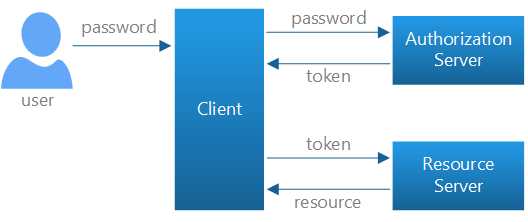
这种模式的流程非常简单:
此时third party application代表我们自己的客户端,Authorization server和Resource owner代表我们自己的webApi服务。我们在日志网站的场景中提到:用户不能直接为日志网站(third party application)提供QQ(resource owner)的用户名和密码。而此时third party application、authorization server、resource owner都是一家人,Resource owner对third party application足够信任,所以我们才能采取这种模式来实现。
五、使用owin来实现密码模式
owin集成了OAuth2.0的实现,所以在webapi中使用owin来打造authorization无疑是最简单最方便的方案。
Microsoft.AspNet.WebApi.Owin
Microsoft.Owin.Host.SystemWeb
在项目中新建一个类,命名为Startup.cs,这个类将作为owin的启动入口,添加下面的代码
|
1
2
3
4
5
6
7
8
9
10
11
12
13
14
15
|
[assembly: OwinStartup(typeof(OAuthPractice.ProtectedApi.Startup))]namespace OAuthPractice.ProtectedApi{ public class Startup { public void Configuration(IAppBuilder app) { var config = new HttpConfiguration(); WebApiConfig.Register(config); app.UseWebApi(config); } }} |
另外修改WebApiConfig.Register(HttpConfiguration config)方法:
|
1
2
3
4
5
6
7
8
9
10
11
12
13
14
15
16
|
public static class WebApiConfig{ public static void Register(HttpConfiguration config) { config.MapHttpAttributeRoutes(); config.Routes.MapHttpRoute( name: "DefaultApi", routeTemplate: "api/{controller}/{id}", defaults: new { id = RouteParameter.Optional } ); var jsonFormatter = config.Formatters.OfType<JsonMediaTypeFormatter>().First(); jsonFormatter.SerializerSettings.ContractResolver = new CamelCasePropertyNamesContractResolver(); }} |
最后两句话将会使用CamelCase命名法序列化webApi的返回结果。
3.使用ASP.NET Identity 实现一个简单的用户认证功能,以便我们生成用户名和密码
安装nuget package:
Microsoft.AspNet.Identity.Owin
Microsoft.AspNet.Identity.EntityFramework
4.新建一个Auth的文件夹,并添加AuthContext类:
|
1
2
3
4
5
6
7
|
public class AuthContext : IdentityDbContext<IdentityUser> { public AuthContext():base("AuthContext") { } } |
同时在web.config中添加connectionString:
|
1
2
3
|
<connectionStrings> <add name="AuthContext" connectionString="Data Source=.;Initial Catalog=OAuthPractice;Integrated Security=SSPI;" providerName="System.Data.SqlClient" /></connectionStrings> |
5.增加一个Entities文件夹并添加UserModel类:
|
1
2
3
4
5
6
7
8
9
10
11
12
13
14
15
16
17
|
public class UserModel{ [Required] [Display(Name = "UserModel name")] public string UserName { get; set; } [Required] [StringLength(100, ErrorMessage = "The {0} must be at least {2} characters long.", MinimumLength = 6)] [DataType(DataType.Password)] [Display(Name = "Password")] public string Password { get; set; } [DataType(DataType.Password)] [Display(Name = "Confirm password")] [Compare("Password", ErrorMessage = "The password and confirmation password do not match.")] public string ConfirmPassword { get; set; } } |
6.在Auth文件夹下添加AuthRepository类,增加用户注册和查找功能:
|
1
2
3
4
5
6
7
8
9
10
11
12
13
14
15
16
17
18
19
20
21
22
23
24
25
26
27
28
29
30
31
32
33
34
35
36
37
38
|
public class AuthRepository : IDisposable{ private AuthContext _ctx; private UserManager<IdentityUser> _userManager; public AuthRepository() { _ctx = new AuthContext(); _userManager = new UserManager<IdentityUser>(new UserStore<IdentityUser>(_ctx)); } public async Task<IdentityResult> RegisterUser(UserModel userModel) { IdentityUser user = new IdentityUser { UserName = userModel.UserName }; var result = await _userManager.CreateAsync(user, userModel.Password); return result; } public async Task<IdentityUser> FindUser(string userName, string password) { IdentityUser user = await _userManager.FindAsync(userName, password); return user; } public void Dispose() { _ctx.Dispose(); _userManager.Dispose(); }} |
7、增加AccountController
|
1
2
3
4
5
6
7
8
9
10
11
12
13
14
15
16
17
18
19
20
21
22
23
24
25
26
27
28
29
30
31
32
33
34
35
36
37
38
39
40
41
42
43
44
45
46
47
48
49
50
51
52
53
54
55
56
57
58
59
60
61
62
63
64
65
66
67
68
69
70
71
|
[RoutePrefix("api/Account")]public class AccountController : ApiController{ private readonly AuthRepository _authRepository = null; public AccountController() { _authRepository = new AuthRepository(); } // POST api/Account/Register [AllowAnonymous] [Route("Register")] public async Task<IHttpActionResult> Register(UserModel userModel) { if (!ModelState.IsValid) { return BadRequest(ModelState); } IdentityResult result = await _authRepository.RegisterUser(userModel); IHttpActionResult errorResult = GetErrorResult(result); if (errorResult != null) { return errorResult; } return Ok(); } protected override void Dispose(bool disposing) { if (disposing) { _authRepository.Dispose(); } base.Dispose(disposing); } private IHttpActionResult GetErrorResult(IdentityResult result) { if (result == null) { return InternalServerError(); } if (!result.Succeeded) { if (result.Errors != null) { foreach (string error in result.Errors) { ModelState.AddModelError("", error); } } if (ModelState.IsValid) { // No ModelState errors are available to send, so just return an empty BadRequest. return BadRequest(); } return BadRequest(ModelState); } return null; }} |
Register方法打上了AllowAnonymous标签,意味着调用这个api无需任何授权。
8.增加一个OrderControll,添加一个受保护的api用来做实验
在Models文件夹下增加Order类:
|
1
2
3
4
5
6
7
8
9
10
11
12
13
14
15
16
17
18
19
20
21
|
public class Order{ public int OrderID { get; set; } public string CustomerName { get; set; } public string ShipperCity { get; set; } public Boolean IsShipped { get; set; } public static List<Order> CreateOrders() { List<Order> OrderList = new List<Order> { new Order {OrderID = 10248, CustomerName = "Taiseer Joudeh", ShipperCity = "Amman", IsShipped = true }, new Order {OrderID = 10249, CustomerName = "Ahmad Hasan", ShipperCity = "Dubai", IsShipped = false}, new Order {OrderID = 10250,CustomerName = "Tamer Yaser", ShipperCity = "Jeddah", IsShipped = false }, new Order {OrderID = 10251,CustomerName = "Lina Majed", ShipperCity = "Abu Dhabi", IsShipped = false}, new Order {OrderID = 10252,CustomerName = "Yasmeen Rami", ShipperCity = "Kuwait", IsShipped = true} }; return OrderList; }} |
增加OrderController类:
|
1
2
3
4
5
6
7
8
9
10
11
|
[RoutePrefix("api/Orders")]public class OrdersController : ApiController{ [Authorize] [Route("")] public List<Order> Get() { return Order.CreateOrders(); }} |
我们在Get()方法上加了Authorize标签,所以此api在没有授权的情况下将返回401 Unauthorize。使用postman发个请求试试:
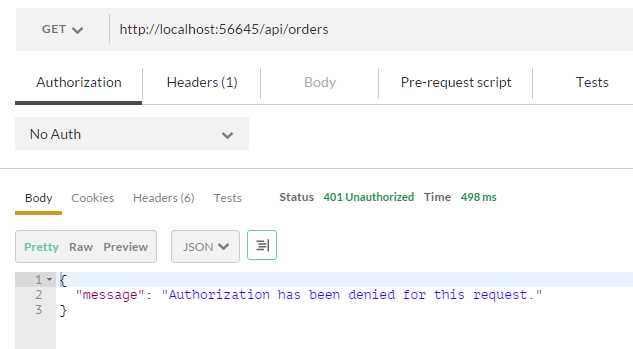
9. 增加OAuth认证
|
1
2
3
4
5
6
7
8
9
10
11
12
13
14
15
16
17
18
19
20
21
22
23
24
25
26
27
|
public class Startup{ public void Configuration(IAppBuilder app) { var config = new HttpConfiguration(); WebApiConfig.Register(config); ConfigureOAuth(app); //这一行代码必须放在ConfiureOAuth(app)之后 app.UseWebApi(config); } public void ConfigureOAuth(IAppBuilder app) { OAuthAuthorizationServerOptions OAuthServerOptions = new OAuthAuthorizationServerOptions() { AllowInsecureHttp = true, TokenEndpointPath = new PathString("/token"), AccessTokenExpireTimeSpan = TimeSpan.FromMinutes(30), Provider = new SimpleAuthorizationServerProvider() }; // Token Generation app.UseOAuthAuthorizationServer(OAuthServerOptions); app.UseOAuthBearerAuthentication(new OAuthBearerAuthenticationOptions()); } |
ConfigureOAuth(IAppBuilder app)方法开启了OAuth服务。简单说一下OAuthAuthorizationServerOptions中各参数的含义:
AllowInsecureHttp:允许客户端使用http协议请求;
TokenEndpointPath:token请求的地址,即http://localhost:端口号/token;
AccessTokenExpireTimeSpan :token过期时间;
Provider :提供具体的认证策略;
SimpleAuthorizationServerProvider的代码如下:
|
1
2
3
4
5
6
7
8
9
10
11
12
13
14
15
16
17
18
19
20
21
22
23
24
25
26
27
28
29
30
31
32
33
34
35
36
37
38
39
40
41
42
43
44
45
46
47
48
49
50
|
public class SimpleAuthorizationServerProvider : OAuthAuthorizationServerProvider{ public override Task ValidateClientAuthentication(OAuthValidateClientAuthenticationContext context) { context.Validated(); return Task.FromResult<object>(null); } public override async Task GrantResourceOwnerCredentials(OAuthGrantResourceOwnerCredentialsContext context) { using (AuthRepository _repo = new AuthRepository()) { IdentityUser user = await _repo.FindUser(context.UserName, context.Password); if (user == null) { context.SetError("invalid_grant", "The user name or password is incorrect."); return; } } var identity = new ClaimsIdentity(context.Options.AuthenticationType); identity.AddClaim(new Claim(ClaimTypes.Name, context.UserName)); identity.AddClaim(new Claim(ClaimTypes.Role, "user")); identity.AddClaim(new Claim("sub", context.UserName)); var props = new AuthenticationProperties(new Dictionary<string, string> { { "as:client_id", context.ClientId ?? string.Empty }, { "userName", context.UserName } }); var ticket = new AuthenticationTicket(identity, props); context.Validated(ticket); } public override Task TokenEndpoint(OAuthTokenEndpointContext context) { foreach (KeyValuePair<string, string> property in context.Properties.Dictionary) { context.AdditionalResponseParameters.Add(property.Key, property.Value); } return Task.FromResult<object>(null); }} |
ValidateClientAuthentication方法用来对third party application 认证,具体的做法是为third party application颁发appKey和appSecrect,在本例中我们省略了颁发appKey和appSecrect的环节,我们认为所有的third party application都是合法的,context.Validated(); 表示所有允许此third party application请求。
GrantResourceOwnerCredentials方法则是resource owner password credentials模式的重点,由于客户端发送了用户的用户名和密码,所以我们在这里验证用户名和密码是否正确,后面的代码采用了ClaimsIdentity认证方式,其实我们可以把他当作一个NameValueCollection看待。最后context.Validated(ticket); 表明认证通过。
只有这两个方法同时认证通过才会颁发token。
TokenEndpoint方法将会把Context中的属性加入到token中。
10、注册用户
使用postman发送注册用户的请求(http://{url}/api/account/register)服务器返回200,说明注册成功。
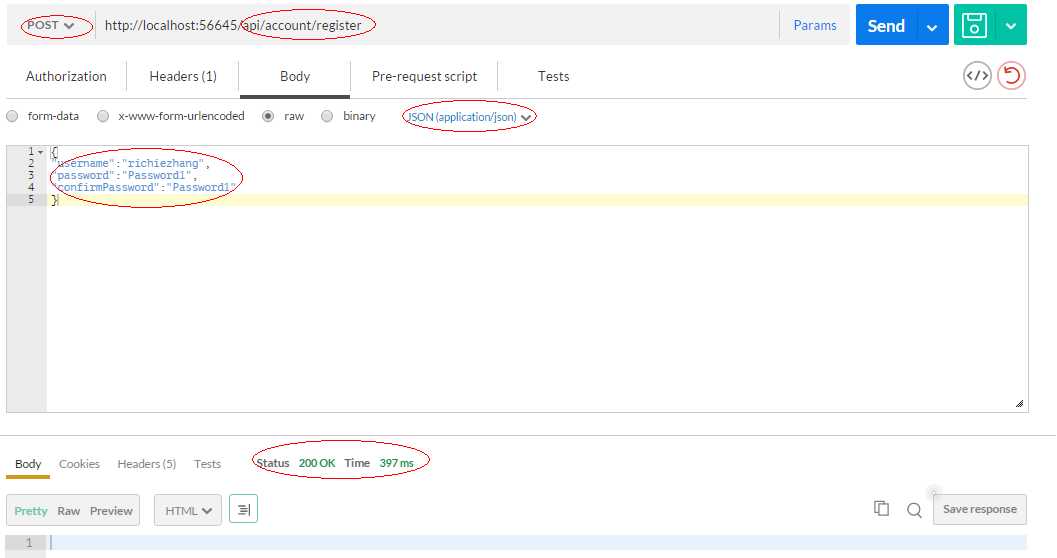
11、向服务器请求token
resource owner password credentials模式需要body包含3个参数:
grant_type-必须为password
username-用户名
password-用户密码
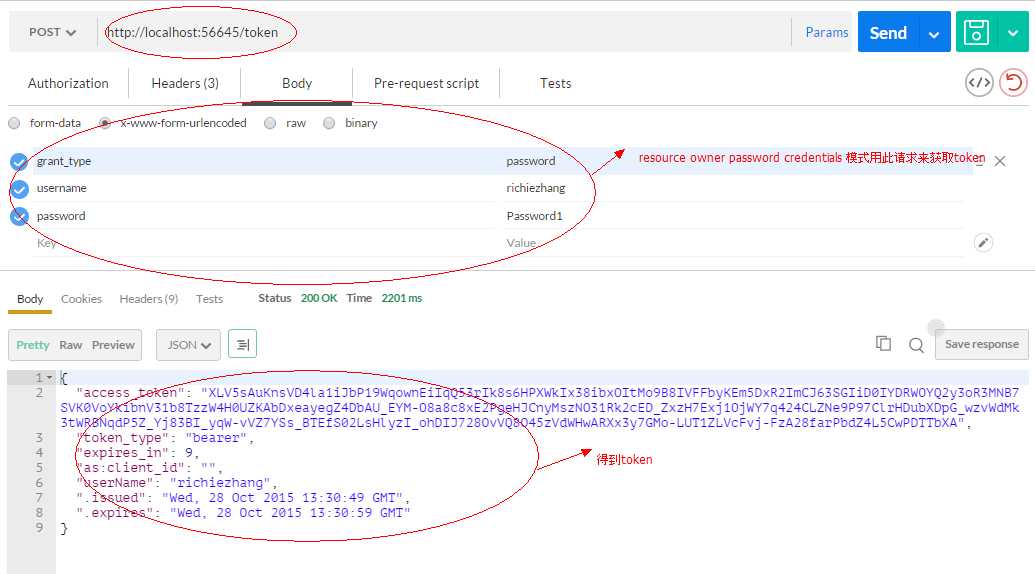
12、使用token访问受保护的api
在Header中加入:Authorization – bearer {{token}},此token就是上一步得到的token。
此时客户端在30分钟内使用该token即可访问受保护的资源。30分钟这个设置来自AccessTokenExpireTimeSpan = TimeSpan.FromMinutes(30),你可以自定义token过期时间。
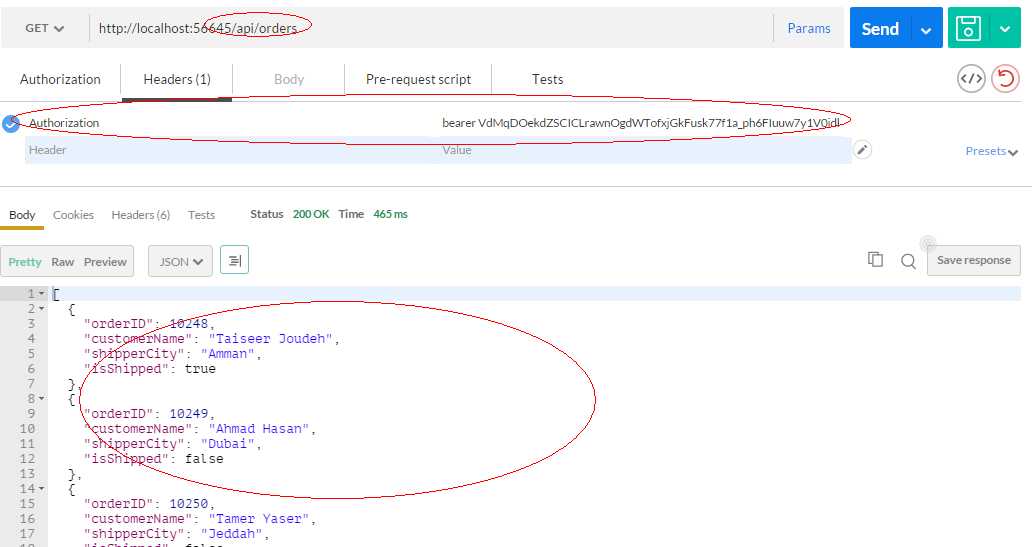
六、刷新token
当token过期后,OAuth2.0提供了token刷新机制:
|
1
2
3
4
5
6
7
8
9
10
11
12
13
14
15
16
17
|
public void ConfigureOAuth(IAppBuilder app){ OAuthAuthorizationServerOptions OAuthServerOptions = new OAuthAuthorizationServerOptions() { AllowInsecureHttp = true, TokenEndpointPath = new PathString("/token"), AccessTokenExpireTimeSpan = TimeSpan.FromSeconds(10), Provider = new SimpleAuthorizationServerProvider(), //refresh token provider RefreshTokenProvider = new SimpleRefreshTokenProvider() }; // Token Generation app.UseOAuthAuthorizationServer(OAuthServerOptions); app.UseOAuthBearerAuthentication(new OAuthBearerAuthenticationOptions());} |
1、添加新的RefreshTokenProvider
|
1
2
3
4
5
6
7
8
9
10
11
12
13
14
15
16
17
18
19
20
21
22
23
24
25
26
27
28
29
30
31
32
33
34
35
36
37
38
39
40
41
42
43
44
45
46
47
48
49
50
51
52
53
54
55
56
57
58
59
60
61
|
public class SimpleRefreshTokenProvider : IAuthenticationTokenProvider{ public async Task CreateAsync(AuthenticationTokenCreateContext context) { var refreshTokenId = Guid.NewGuid().ToString("n"); using (AuthRepository _repo = new AuthRepository()) { var token = new RefreshToken() { Id = refreshTokenId.GetHash(), Subject = context.Ticket.Identity.Name, IssuedUtc = DateTime.UtcNow, ExpiresUtc = DateTime.UtcNow.AddMinutes(30) }; context.Ticket.Properties.IssuedUtc = token.IssuedUtc; context.Ticket.Properties.ExpiresUtc = token.ExpiresUtc; token.ProtectedTicket = context.SerializeTicket(); var result = await _repo.AddRefreshToken(token); if (result) { context.SetToken(refreshTokenId); } } } public async Task ReceiveAsync(AuthenticationTokenReceiveContext context) { string hashedTokenId = context.Token.GetHash(); using (AuthRepository _repo = new AuthRepository()) { var refreshToken = await _repo.FindRefreshToken(hashedTokenId); if (refreshToken != null) { //Get protectedTicket from refreshToken class context.DeserializeTicket(refreshToken.ProtectedTicket); var result = await _repo.RemoveRefreshToken(hashedTokenId); } } } public void Create(AuthenticationTokenCreateContext context) { throw new NotImplementedException(); } public void Receive(AuthenticationTokenReceiveContext context) { throw new NotImplementedException(); }} |
我们实现了其中两个异步方法,对两个同步方法不做实现。其中CreateAsync用来生成RefreshToken值,生成后需要持久化在数据库中,客户端需要拿RefreshToken来请求刷新token,此时ReceiveAsync方法将拿客户的RefreshToken和数据库中RefreshToken做对比,验证成功后删除此refreshToken。
2、重新请求token
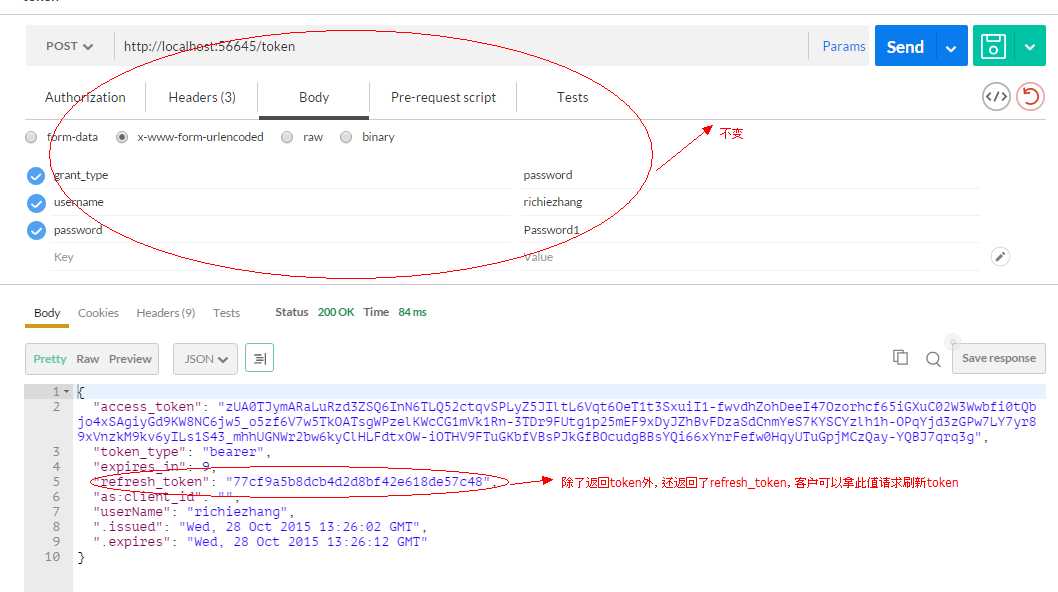
可以看到这次请求不但得到了token,还得到了refresh_token
3、当token过期后,凭借上次得到的refresh_token重新获取token
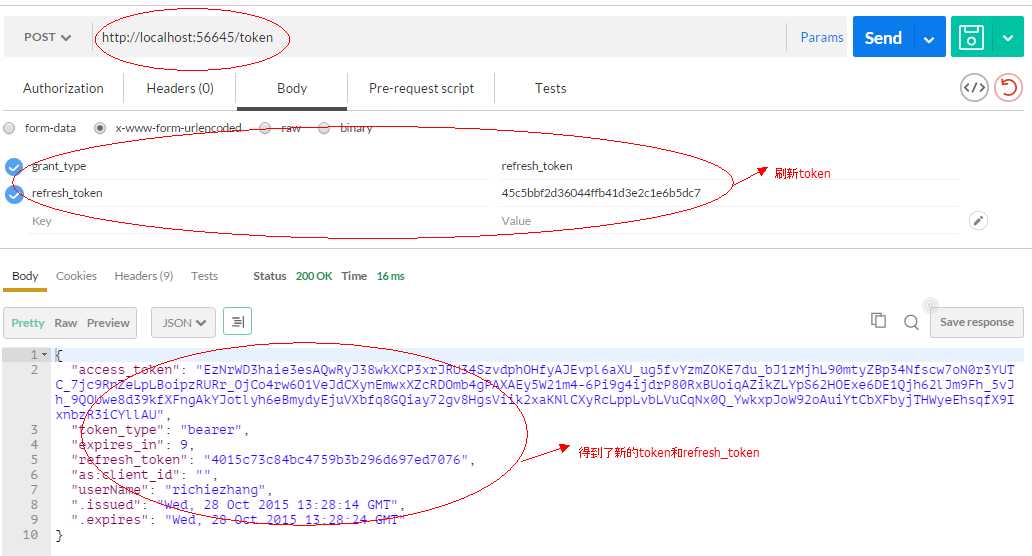
此次请求又得到了新的refresh_token,每次refresh_token只能用一次,因为在方法ReceiveAsync中我们一旦拿到refresh_token就删除了记录。
七、总结
此文重点介绍了OAuth2.0中resource owner password credentials模式的使用,此模式可以实现资源服务为自己的客户端授权。另外文章中也提到模式4-client credentials也可以实现这种场景,但用来给有服务端的客户端使用-区别于纯html+js客户端。原因在于模式4-client credentials使用appKey+appSecrect来验证客户端,如果没有服务端的话appSecrect将暴露在js中。
同样的道理:模式1-授权码模式(authorization code)和模式2-简化模式(implicit)的区别也在于模式2-简化模式(implicit)用在无服务端的场景下,请求头中不用带appSecrect。
在webApi中使用owin来实现OAuth2.0是最简单的解决方案,另外一个方案是使用DotNetOpenOauth,这个方案的实现稍显复杂,可用的文档也较少,源码中带有几个例子我也没有直接跑起来,最后无奈之下几乎读完了整个源码才理解。
八、客户端的实现
我们将采用jquery和angular两种js框架来调用本文实现的服务端。下一篇将实现此功能,另外还要给我们的服务端加上CORS(同源策略)支持。
所有的代码都同步更新在 https://git.oschina.net/richieyangs/OAuthPractice.git
使用OAuth打造webapi认证服务供自己的客户端使用(二)
参考:
http://www.asp.net/aspnet/overview/owin-and-katana/owin-oauth-20-authorization-server
http://www.asp.net/web-api/overview/security/individual-accounts-in-web-api
http://bitoftech.net/2014/06/01/token-based-authentication-asp-net-web-api-2-owin-asp-net-identity/
标签:
原文地址:http://www.cnblogs.com/zhyp/p/5468959.html